Percorsi storico-numismatici: la monetazione giapponese tra simbolo e sovranità
Nara Period
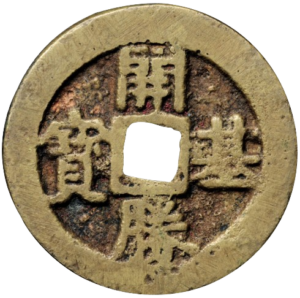
Kaiki Shōhō (Oro)
Anno: 760 d.c.
Kaiki Shōhō (開基勝寳) (Ginza Coins Collection, Tokyo. Reproduction authorized. © All rights reserved.) Nel 760 d.C., durante il quarto anno dell’era Tenpyō-hōji, il ministro Fujiwara no Emi no Oshikatsu promosse…
Leggi di più
Kaiki Shōhō (開基勝寳)
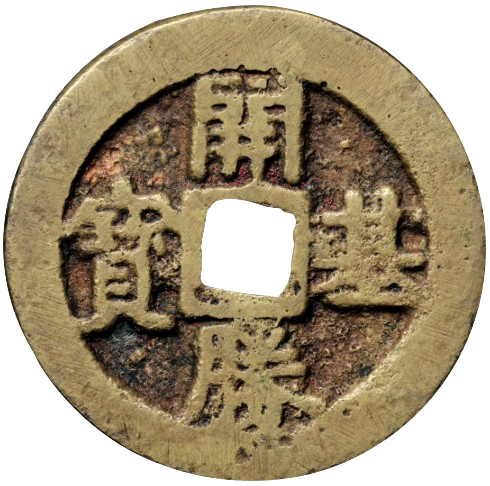
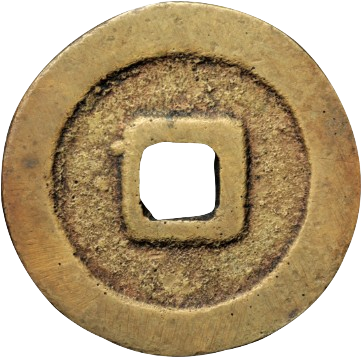
(Ginza Coins Collection, Tokyo. Reproduction authorized. © All rights reserved.)
In 760 AD, during the 4th year of the Tenpyō-hōji era, Minister Fujiwara no Emi no Oshikatsu promoted the minting of the Kaiki Shōhō, considered the first official gold coin of Japan. The existence of only thirty-two known specimens highlights the exceptional rarity of this issue.
The coin, made of gold, features a circular shape with a square central hole, in line with styles inspired by Chinese coinage. The inscription 開基勝寳, engraved on the obverse, is traditionally attributed to the famous calligrapher Kibi no Makibi, a prominent figure of the Nara period.
Variations in size and weight (between 11 and 17.5 grams) have led many scholars to rule out its use in everyday economic transactions. Instead, the prevailing theory identifies the Kaiki Shōhō as a ceremonial or commemorative object, possibly linked to religious or political events.
The first discoveries date back to 1794, when some workers found a specimen near the Saidai-ji temple in Nara. Later, in 1937, thirty-one more were unearthed during archaeological excavations in the same area. Today, all known Kaiki Shōhō coins belong to Japanese public collections. Among them, the Tokyo National Museum preserves several specimens classified as an Important Cultural Property, bearing witness to the deep historical, political, and spiritual meaning the coin holds within the context of ancient Japan.
| Coin Name | Kaiki Shōhō |
| Japanese Inscription | 開基勝寳 |
| Historical Period | Nara Period (710–794 AD) |
| Year of Minting | 760 d.c. |
| Chronological Reference | 4th year of the Tenpyō-hōji era |
| Minting Location | Nara |
| Issuing Authority | Fujiwara no Emi no Oshikatsu |
| Function | Ceremonial |
| Material | Gold |
| Shape | Circular |
| Diameter | 2.3 cm |
| Thickness | 3.7 mm |
| Weight | 11 g – 17.5 g |
| Manufacturing Technique | Casting |
| Obverse Text and Symbols | 開基勝寳 Kaiki Shōhō |
| Reverse Text and Symbols | None |
| Calligrapher / Artist: | Kibi no Makibi |
| Museum References | Tokyo National Museum E-19576~19580 Currency Museum BOJ |
| Number of Known Specimens | 32 |
Sources and Bibliography
The Gold of the Tokugawa, Alberto Rolfini, 2025
Tokyo National Museum, Numismatic Catalog, vol. II
Takizawa Takeo (瀧澤武雄), *Kahei – A Brief Encyclopedia of Japanese Monetary History*, 1999
Sengoku Period
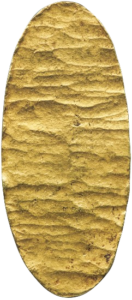
Hirumokin (Oro)
Anno: 1501 – 1588 d.c.
Hirumokin (蛭藻金) (Ginza Coins Collection, Tokyo. Reproduction authorized. © All rights reserved.) Le Hirumokin rappresentano una tappa significativa nella storia della monetazione giapponese. Coniate tra il 1501 e il 1588,…
Leggi di più
Hirumokin (蛭藻金)
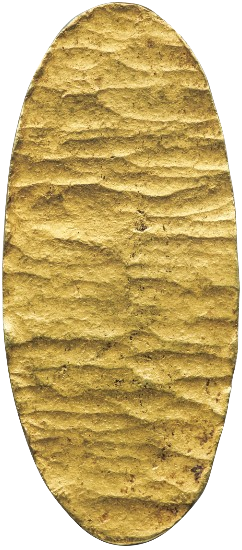
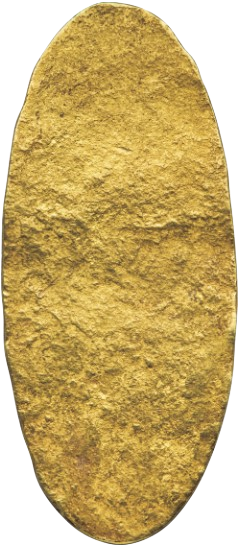
(Ginza Coins Collection, Tokyo. Reproduction authorized. © All rights reserved.)
The Hirumokin represent a significant chapter in the history of Japanese coinage. Minted between 1501 and 1588, during a period of political transition and military unrest, these gold coins take their name from their resemblance to the leaves of the aquatic plant hirumo. Produced using advanced casting and engraving techniques, they were created by hammering gold sheets against stone until the desired shape was achieved. While similar in appearance to the better-known Ōban, Hirumokin were smaller and likely held lower monetary value. They are distinguished by their elongated shape and smooth surface, sometimes engraved with distinctive symbols upon request from local lords. The lack of standardization is evident in the variation in weight (up to 140 grams) and length (110–116 mm). Historical information remains limited, adding to the mystery surrounding these coins. In 1971, an archaeological discovery in Kōfu (Yamanashi Prefecture) uncovered numerous examples of Hirumokin and gold ingots, confirming the region's connection to Takeda Nobutomo, a key figure in the earliest phases of Japanese gold coinage.
| Coin Name | Hirumokin |
| Japanese Inscription | 蛭藻金 |
| Historical Period | Sengoku Period (1467–1603 AD) |
| Year of Minting | 1501 – 1588 d.c. |
| Chronological Reference | Unspecified |
| Minting Location | Unspecified |
| Issuing Authority | Not definitively established |
| Function | Effective coinage (used for both commercial transactions and symbolic purposes, associated with local authority) |
| Material | Gold |
| Shape | Elongated |
| Height | 11 – 11.6 cm |
| Width | 4.5- 5.2 cm |
| Weight | 115 – 140 g |
| Manufacturing Technique | Manually executed casting and striking performed on stone surfaces |
| Obverse Text and Symbols | At times featuring symbolic, non-standardized engravings |
| Reverse Text and Symbols | None |
| Calligrapher / Artist: | Unspecified |
| Museum References | Tokyo National Museum E-20082 Currency Museum Bank of Japan ⅡAカマb1/5 |
| Number of Known Specimens | A considerable number of specimens are known, although not quantified with precision; a particularly important discovery occurred in Kōfu in 1971 |
References and Bibliography
The Gold of Tokugawa, Alberto Rolfini 2025
Yamada Hagaki and the History of Paper Currency in Japan 1996
瀧澤武雄, 貨幣 Takizawa Takeo, Kahei Nipponshi sho Hyakka 1999
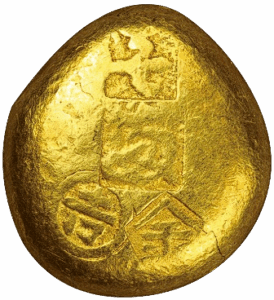
Kōshū Ryō Kin (Oro)
Anno: 1578 – 1609 d.C.
Kōshū Ryō Kin (甲州両金) (Ginza Coins Collection, Tokyo. Reproduction authorized. © All rights reserved.) Le Koshu Ichi Ryō Kin (甲州一両金), o Tsuyu Ichi Ryō (露一両), sono monete d’oro da un…
Leggi di più
Kōshū Ryō Kin
(甲州両金)
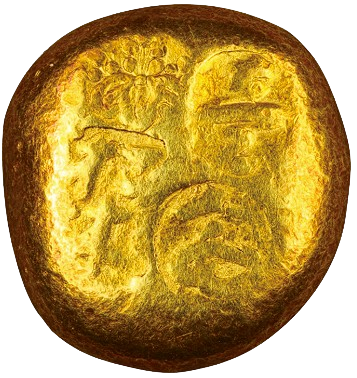

(Ginza Coins Collection, Tokyo. Reproduction authorized. © All rights reserved.)
Koshu Ichi Ryō Kin (甲州一両金), or Tsuyu Ichi Ryō (露一両), are gold coins of one ryō issued between the Tenshō period (1573–1592) and the early Edo era. Their shape, resembling a "dew drop," reflects the manual production methods of the time. They belong to the Ko Kōshūkin, with an average weight of 15.2 grams. Minted between 1578 and 1609 in the Kai region (present-day Yamanashi), these coins feature inscriptions such as 「金吉」(Kinkichi), 「上字」(Jōji), and 「甲」(Kō), indicating mints or quality. The Paulownia seal (桐紋, Kiri-mon), a symbol of Kai, guaranteed their authenticity. A rare variant, the Koma Ichi Ryō (駒一両), is adorned with a stylized horse, a symbolic or toponymic reference. Few specimens survive, preserved in private or museum collections.
| Coin Name | Kōshū Ryō Kin |
| Japanese Inscription | 甲州両金 |
| Historical Period | Sengoku Period (1467 –1603 d.C.) Edo Period (1603-1868 d.C.) |
| Year of Minting | 1578–1609 d.C. |
| Chronological Reference | Kai Province (Koshu), post-Takeda period |
| Minting Location | Koshu (Kai) |
| Issuing Authority | Tokugawa Clan / Post-Takeda Transition Period |
| Function | Effective coinage (used for both commercial transactions and symbolic purposes, associated with local authority) |
| Material | Gold |
| Shape | Circular or Drop-shaped |
| Height | Undefined |
| Width | Undefined |
| Weight | 15,1-15,2 g |
| Manufacturing Technique | Manual casting and hammering |
| Obverse Text and Symbols | Gosan Kiri Seal Inscription: Ichi Ryō 壹両 (number in Daiji style) Kinkichi (金吉), Jōji (上字), or Kō (甲) |
| Reverse Text and Symbols | None |
| Calligrapher / Artist: | Unspecified |
| Museum References | Currency Museum Bank of Japan ⅡAカマb 12/1 ⅡAカマb 12/6 |
| Number of Known Specimens | Extremely rare; only a few specimens preserved |
Sources and Bibliography
The Gold of Tokugawa, Alberto Rolfini 2025
瀧澤武雄, 貨幣 Takizawa Takeo, Kahei Nipponshi sho Hyakka 1999
Periodo Tenshō
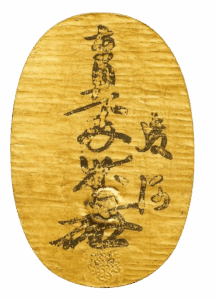
Suruga Sumigaki Koban Kin (Oro)
Anno: 1582 d.c.
Suruga Sumigaki Koban Kin (駿河墨書小判金) (Ginza Coins Collection, Tokyo. Reproduction authorized. © All rights reserved.) Il Suruga Sumigaki Koban Kin è una moneta d’oro dal valore di 1 ryō, simile…
Leggi di più
Suruga Sumigaki
Koban Kin
(駿河墨書小判金)
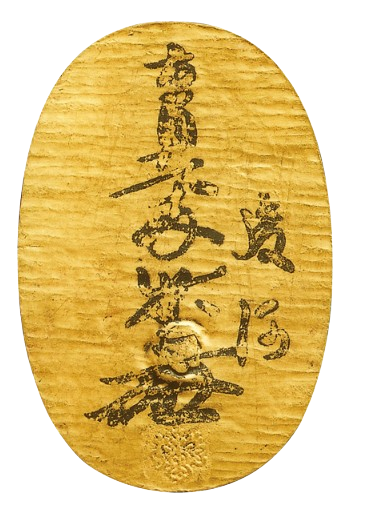
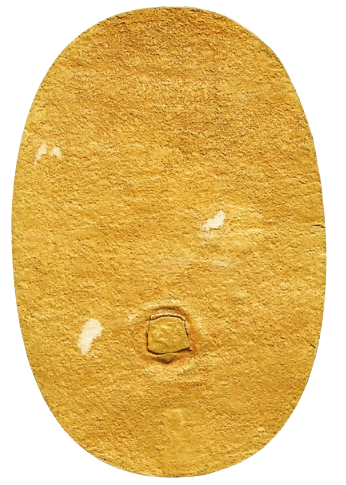
(Ginza Coins Collection, Tokyo. Reproduction authorized. © All rights reserved.)
The Suruga Sumigaki Koban Kin is a gold coin with a value of 1 ryō, similar to the Tenshō Ōban. Its origins are uncertain: one theory claims it was minted by Tokugawa Ieyasu in 1582, after his move to Suruga to support Oda Nobunaga; according to the Kin Gin Zuroku, however, the coin dates back to 1595, an idea that contradicts Ieyasu’s direct involvement. Another version attributes the minting to Nakamura Kazuuji, a loyal retainer of Toyotomi Hideyoshi, as a political move against the Tokugawa. It is believed to have been minted in either Suruga or Kyoto. The Kaō, resembling an incomplete “Jō” (乗) character, reflects the style of the Gotō family, suggesting the coin was produced under the supervision of Gotō Chōjō, a trusted artisan of Tokugawa and creator of the Keichō Sasagaki Ōban.
| Coin Name | Suruga Sumigaki Koban Kin |
| Japanese Inscription | 駿河墨書小判金 |
| Historical Period | Tenshō Period (1573–1592 d.C.) |
| Year of Minting | 1582 – 1595 d.c. |
| Chronological Reference | Suruga or Kyoto |
| Minting Location | Probably Suruga or Kyoto |
| Issuing Authority | Possible Tokugawa Ieyasu or Nakamura Kazuuji |
| Function | Political and symbolic use; possible limited use in circulation |
| Material | Gold |
| Shape | Oval |
| Height | 7.7 cm |
| Width | 5 cm |
| Weight | 16.9 g |
| Manufacturing Technique | Manual hammering |
| Obverse Text and Symbols | Engraving of 京目壱両 (Kyōme Ichi Ryō), Kaō, “Suruga,” and Gosan Kiri seal |
| Reverse Text and Symbols | None |
| Calligrapher / Artist: | Probable involvement of Gotō Chōjō |
| Museum References | Currency Museum Bank of Japan ⅡAカマb 11/1 |
| Number of Known Specimens | Very rare; few known specimens |
Sources and Bibliography
The Gold of Tokugawa, Alberto Rolfini 2025
瀧澤武雄, 貨幣 Takizawa Takeo, Kahei Nipponshi sho Hyakka 1999
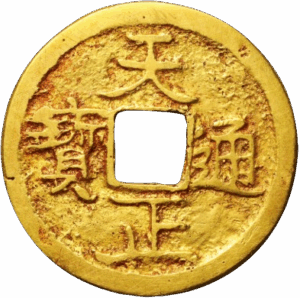
Tenshō Tsūhō Kin (Oro)
Anno: 1587 d.c.
Tenshō Tsūhō Kin (天正通宝金) (Ginza Coins Collection, Tokyo. Reproduction authorized. © All rights reserved.) Il Tenshō Tsūhō Kin costituisce una rilevante testimonianza delle riforme economiche di Toyotomi Hideyoshi durante il…
Leggi di più
Tenshō Tsūhō Kin
(天正通宝金)
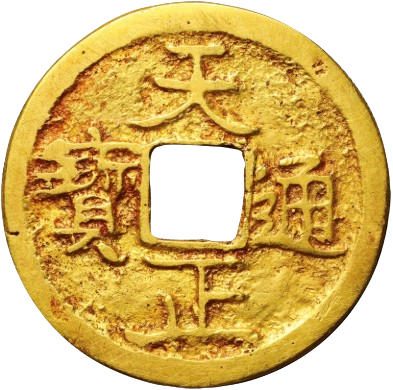
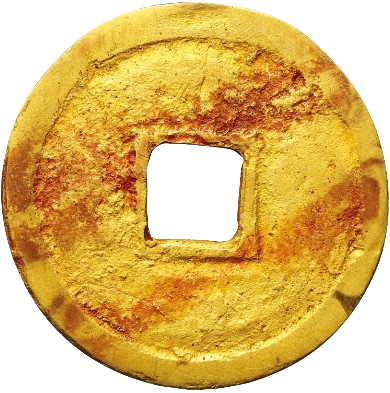
(Ginza Coins Collection, Tokyo. Reproduction authorized. © All rights reserved.)
The Tenshō Tsūhō Kin represents a significant testament to the economic reforms enacted by Toyotomi Hideyoshi during the Tenshō period (1573–1592). Issued in 1587, these coins were primarily employed as rewards for loyal samurai and daimyō, thereby reinforcing political allegiance and central control. Weighing 5.4 grams and measuring 2.3 cm in diameter, they bore the inscription 天正通宝 (Tenshō Tsūhō) on the obverse, while the reverse remained unmarked, reflecting a sober and functional design. Crafted from gilded copper, their value was more symbolic than commercial. Although also intended for civilian circulation, their usage remained limited due to their high value. These coins formed part of Hideyoshi’s broader initiative to centralize authority and construct a unified economic identity.
| Coin Name | Tenshō Tsūhō Kin |
| Japanese Inscription | 天正通宝金 |
| Historical Period | Tenshō Period (1573–1592 d.C.) |
| Year of Minting | 1587 d.c. |
| Chronological Reference | Unspecified |
| Minting Location | Unspecified |
| Issuing Authority | Toyotomi Hideyoshi |
| Function | A symbolic reward for loyal samurai and daimyō; its circulation as currency remained limited. |
| Material | Gold (gilded copper alloy) |
| Shape | Circular |
| Height | 2.3 cm |
| Width | 2.3 cm |
| Weight | 5.4 g |
| Manufacturing Technique | Manually executed casting and striking performed on stone surfaces |
| Obverse Text and Symbols | Inscribed with 天正通宝Tenshō Tsūhō) |
| Reverse Text and Symbols | None |
| Calligrapher / Artist: | Unspecified |
| Museum References | Currency Museum Bank of Japan ⅡAカマa2 9-1/1 |
| Number of Known Specimens | Numerous known specimens (not precisely quantified) |
Sources and Bibliography
The Gold of Tokugawa, Alberto Rolfini 2025
瀧澤武雄, 貨幣 Takizawa Takeo, Kahei Nipponshi sho Hyakka 1999
Periodo Bunroku
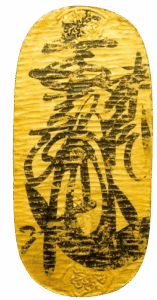
Musashi Sumigaki Koban Kin (Oro)
Anno: 1595 d.C.
Musashi Sumigaki Koban Kin (武蔵墨書小判金) (Ginza Coins Collection, Tokyo. Reproduction authorized. © All rights reserved.) Il Musashi Sumigaki Koban Kin è una moneta d’oro di valore pari a 1 ryō,…
Leggi di più
Musashi Sumigaki
Koban Kin
(武蔵墨書小判金)
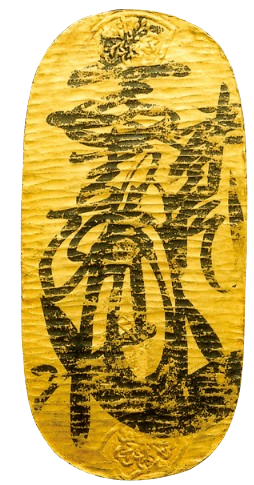
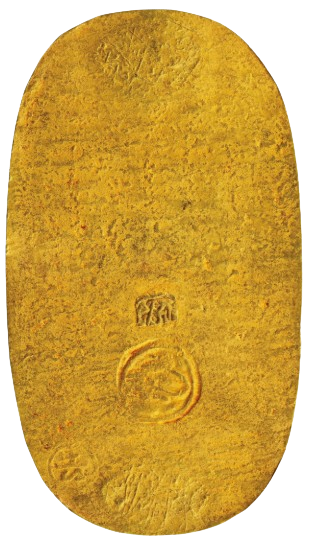
(Ginza Coins Collection, Tokyo. Reproduction authorized. © All rights reserved.)
The Musashi Sumigaki Koban Kin is a gold coin valued at 1 ryō, similar to the Keichō Koban in both size and weight. Its minting is datable to the fourth or fifth year of the Bunroku era (1595–1596), a crucial period during which Tokugawa Ieyasu established his power in Edo and consolidated control over the surrounding provinces. It is plausible that this coin was intended to facilitate trade within the territories under his direct influence. The production is attributed to the Gotō family, a renowned dynasty of artisans specializing in the crafting of precious metals for official purposes. In particular, Gotō Shōzaburō Mitsutsugu, who was sent to Edo by his predecessor Gotō Tokujo in 1595, strengthened the family’s ties with the emerging Tokugawa government. From an iconographic perspective, the obverse of the coin features a central ink inscription reading “1 Ryō” (壱両), accompanied by a kaō (calligraphic signature), the name “Musashi” (武蔵) on the right side, and two Gosan Kiri crests arranged in a fan-like pattern at the top and bottom.
| Coin Name | Musashi Sumigaki Koban Kin |
| Japanese Inscription | 武蔵墨書小判金 |
| Historical Period | Bunroku Period (1592–1596 d.C.) |
| Year of Minting | 1595 d.c. |
| Chronological Reference | Edo or surrounding provinces (Musashi, Suruga) |
| Minting Location | Probably Edo |
| Issuing Authority | Tokugawa Ieyasu |
| Function | Primarily political-symbolic use and prestige minting, with limited circulation. |
| Material | High-purity gold (approximately 84.3%) |
| Shape | Oval |
| Height | 7.8 cm |
| Width | 4.4 cm |
| Weight | 17.8 g |
| Manufacturing Technique | Manually struck with subsequent ink inscription |
| Obverse Text and Symbols | Ink inscription “壱両” (Ichi Ryō), kaō (calligraphic signature), “武蔵” (Musashi), and two Gosan Kiri crests |
| Reverse Text and Symbols | None |
| Calligrapher / Artist: | Probably Gotō Shōzaburō Mitsutsugu |
| Museum References | Currency Museum Bank of Japan ⅡAカマb 10/2 |
| Number of Known Specimens | Extremely rare; only a few known specimens |
Sources and Bibliography
The Gold of Tokugawa, Alberto Rolfini 2025
瀧澤武雄, 貨幣 Takizawa Takeo, Kahei Nipponshi sho Hyakka 1999
Periodo Edo
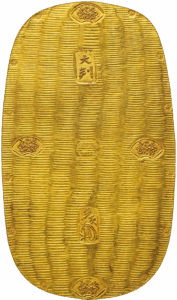
Hachi Ryō Ban Kin (Oro)
Anno: 1605 d.C.
Hachi Ryō Ban Kin (八両判金) (Ginza Coins Collection, Tokyo. Reproduction authorized. © All rights reserved.) Le Hachi Ryō Ban Kin, comunemente conosciute come Taikō Ōban Kin, costituiscono uno dei reperti…
Leggi di più
Hachi Ryō Ban Kin
(八両判金)
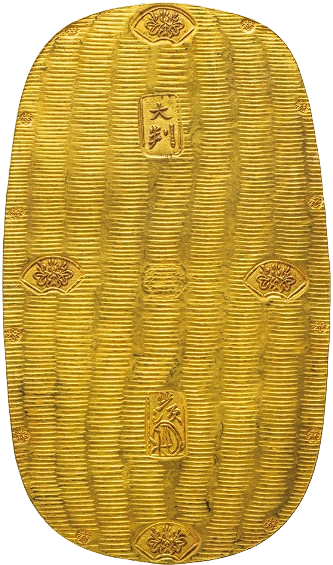
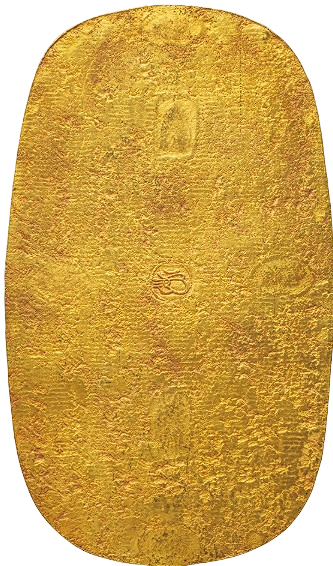
(Ginza Coins Collection, Tokyo. Reproduction authorized. © All rights reserved.)
The Hachi Ryō Ban Kin, commonly known as Taikō Ōban Kin, are among the most fascinating and mysterious numismatic artifacts of Japan. Although traditionally attributed to the period of Toyotomi Hideyoshi, recent historical studies, based on documents preserved by the Gotō Shōzaburō family, custodians of the Kinza (Gold Mint), have revealed a more accurate chronology, placing their production during the Keichō period (1596–1615). A crucial document for understanding their history, the “Kuno Gozu Kingin Ukebarai Chō”, dated to the second year of the Genna era (1616), confirms their existence and limits their minting to the tenth year of the Keichō era (1605), just a few years after the issuance of Keichō Ōban Kin coins. The analysis of the seals imprinted on these coins supports this dating and confirms their authenticity. Despite their historical and cultural significance, only a few authentic examples of the Hachi Ryō Ban Kin have survived, including one displayed at the Currency Museum of the Bank of Japan.
| Coin Name | Hachi Ryō Ban Kin |
| Japanese Inscription | 八両判金 |
| Historical Period | Edo Period (1603-1868 d.C.) |
| Year of Minting | 1605 – ? d.C. |
| Chronological Reference | Japan |
| Minting Location | Unspecified |
| Issuing Authority | ? Toyotomi Hideyoshi ? Clan Tokugawa |
| Function | Effective coinage (used for both commercial transactions and symbolic purposes, associated with local authority) 8 Ryō Value |
| Material | Gold (86.8%) Silver (13.2%) |
| Shape | Oval |
| Height | 15.1 cm |
| Width | 9.0 cm |
| Weight | 142.8 g |
| Manufacturing Technique | Manual casting and hammering |
| Obverse Text and Symbols | Gosan Kiri inscribed in a fan-shaped frame Ōban inscription 大判 Mitsutsugu inscription 光次 Free-standing Gosan Kiri |
| Reverse Text and Symbols | Butterfly-style Kao |
| Calligrapher / Artist: | Unspecified |
| Museum References | Currency Museum Bank of Japan ⅡAエドa 40/1 |
| Number of Known Specimens | Extremely rare; only a few specimens preserved |
Sources and Bibliography
The Gold of Tokugawa, Alberto Rolfini 2025
瀧澤武雄, 貨幣 Takizawa Takeo, Kahei Nipponshi sho Hyakka 1999
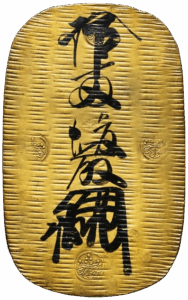
Genroku Ōban Kin (Oro)
Anno: 1695 – 1716 d.C.
Genroku Ōban Kin (元禄大判金) (Ginza Coins Collection, Tokyo. Reproduction authorized. © All rights reserved.) Alla fine del XVII secolo, il Giappone affrontò una profonda crisi economica, aggravata dal declino dell’estrazione…
Leggi di più
Genroku Ōban Kin
(元禄大判金)
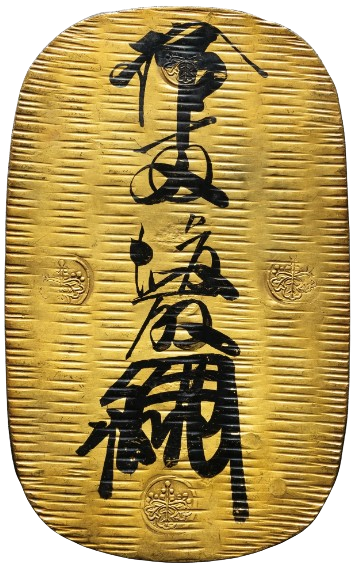
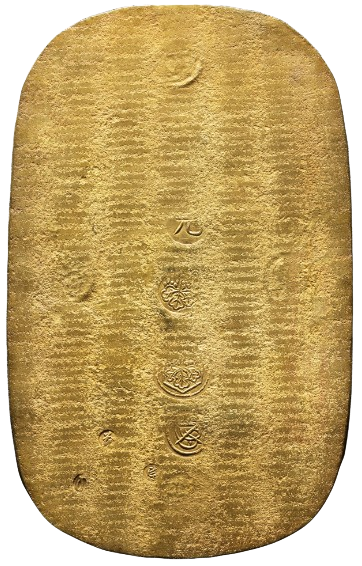
(Ginza Coins Collection, Tokyo. Reproduction authorized. © All rights reserved.)
At the end of the 17th century, Japan faced a deep economic crisis, worsened by the decline in gold and silver extraction and a succession of natural disasters, including the Edo earthquake (1703), the eruption of Mount Fuji (1707), and a smallpox epidemic in the Kantō region (1709). These events severely strained the finances of the Tokugawa shogunate under the leadership of Tokugawa Tsunayoshi. In an attempt to address the monetary contraction, Minister Ogiwara Shigehide implemented a reform that involved issuing new gold coins with a metal content reduced by 20%. Although this measure initially had an expansive effect on the economy, it undermined confidence in the monetary system. Merchants hoarded older coins of higher purity and turned to alternative credit systems, triggering a parallel economy less dependent on the devalued official currency. The social impact was significant: citizens and farmers accumulated durable goods or hid precious metals, indicating a deep systemic distrust. Popular discontent and intellectual pressure, personified by Arai Hakuseki, led to Ogiwara’s dismissal in 1712 and a policy reversal under Tsunayoshi’s successor, Tokugawa Ienobu, followed by Ietsugu. The new coin issues of 1714 aimed to restore monetary quality but triggered severe deflation, affecting the agricultural sector in particular. Within this context emerged the controversial production of the Genroku Ōban, coins of great symbolic value but inconsistent quality and often subject to counterfeiting. Their current rarity makes them valuable material evidence of an era marked by financial instability, political change, and widespread social tensions.
| Coin Name | Genroku Ōban Kin |
| Japanese Inscription | 元禄大判金 |
| Historical Period | Edo Period (1603-1868 d.C.) |
| Year of Minting | 1695 – 1716 d.C. |
| Chronological Reference | Japan |
| Minting Location | Edo, Kyoto |
| Issuing Authority | Clan Tokugawa (Tokugawa Tsunayoshi) |
| Function | Officially minted Value 10 Ryō |
| Material | Gold (67.6 %) Silver (32.4 %) |
| Shape | Oval |
| Height | 15.3 cm |
| Width | 9.4 cm |
| Weight | 165 g |
| Manufacturing Technique | Manual casting and hammering |
| Obverse Text and Symbols | Sigillo Gosan Kiri inscritto in un cerchio Scritta Jū Ryō壹両 (10 Ryō con numero stile Daiji) Firma produttore Ōbanza Gotō Gotō Renjō (後藤廉乗) |
| Reverse Text and Symbols | Inscription: Gen 元 indicating the era Free-standing Gosan Kiri seal Gosan Kiri seal inscribed in a rhombus and in a circle Kao in formal style (Jishin Horitsuke Ban) * Gokuin seals of the producers |
| Calligrapher / Artist: | Gotō Renjō |
| Museum References | |
| Number of Known Specimens | Very rare; only a few specimens preserved |
* In addition to the character Shigeru 茂, one of the following character pairs is also found:
| 七九 | さ九 | 宇九 | 山九 | 坂九 |
Sources and Bibliography
The Gold of Tokugawa, Alberto Rolfini 2025
瀧澤武雄, 貨幣 Takizawa Takeo, Kahei Nipponshi sho Hyakka 1999
Periodo Meiji
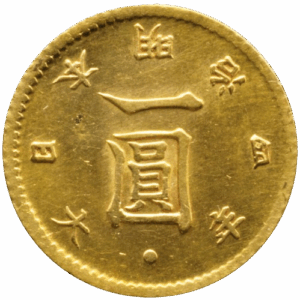
1 Yen Gold Meiji (Oro)
Anno: 1868-1892 d.C.
1 Yen Oro Meiji (一円金明治) (Ginza Coins Collection, Tokyo. Reproduction authorized. © All rights reserved.) La moneta da 1 yen in oro fu introdotta nel 1871 durante l’era Meiji come…
Leggi di più
1 Yen Gold Meiji
(一円金明治)

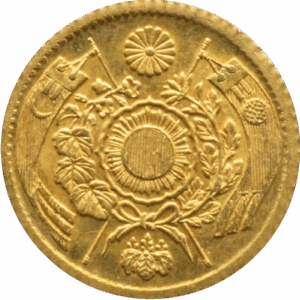
(Ginza Coins Collection, Tokyo. Reproduction authorized. © All rights reserved.)
The 1 yen gold coin was introduced in 1871 during the Meiji era as part of modernization reforms inspired by Western models. Initially minted with larger dimensions, its diameter was reduced in 1872 while maintaining the same weight and fineness, in order to improve practicality and production efficiency. The 1 yen was formally redefined by the 1897 Coinage Law, which established the adoption of the gold standard and guaranteed the gold equivalence of the Japanese currency, strengthening its credibility in international markets. Minted in 900/1000 gold, the coin initially weighed 1.67 grams and measured 13.51 mm, later reduced to 12.15 mm. Its stylistic variations are distinguished by the shape of the character 明 (Mei) and the position of the dot below the Yen character 圓.
Significant Variants of 1871*:
| Tomei 止明 | Chomei 跳明 |
 |
 |
| Full 明 (Mei) character First mintings of 1871 |
Truncated 明 (Mei) character Last mintings of 1871 continued until 1880 |
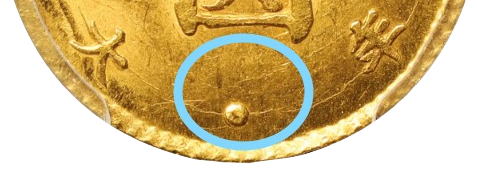 |
 |
| Wider space between the dot and the character 圓 (En) First mintings of 1871 |
Narrower space between the dot and the character 圓 (En) Last mintings of 1871 continued until 1880 |
| Coin Name | 1 Yen Gold Meiji |
| Japanese Inscription | 一円金明治 |
| Historical Period | Meiji Period (1868-1912 d.C.) |
| Year of Minting | 1871-1892 d.C. |
| Chronological Reference | Japan |
| Minting Location | Osaka Mint (official state minting) |
| Issuing Authority | Meiji Government |
| Function | Official Circulation |
| Material | Gold (90%) Copper (10%) |
| Shape | Circular |
| Height | 1871 – 1.35 cm 1874/92 – 1.21 cm |
| Width | 1871 – 1.35 cm 1874/92 – 1.21 cm |
| Weight | 1.67 g |
| Manufacturing Technique | Mechanical Minting |
| Obverse Text and Symbols | 大日本 Dai Nippon (Great Japan) 明治 Meiji Year of Minting In the center 一圓 1 Yen |
| Reverse Text and Symbols | At the top, the imperial chrysanthemum in the center, the Yata no Kagami (sacred mirror) overlaid with rays and flanked by military banners. at the bottom, the paulownia crest (kirimon) |
| Calligrapher / Artist: | Undocumented |
| Museum References | |
| Number of Known Specimens | 1871* (1.841.288) 1874 (116.341) 1876 (138) 1877 (7.246) 1880 (112) 1892 ? |
? Some historical sources mention coins minted in 1892 but never circulated, exhibited at the 1893 World’s Columbian Exposition in Chicago
References and Bibliography
日本貨幣カタログ2025, The Catalog Japanese Coins and Bank Notes, JNDA. Tokyo 2024
瀧澤武雄, 貨幣 Takizawa Takeo, Kahei Nipponshi sho Hyakka 1999
